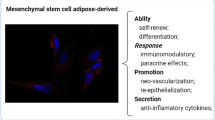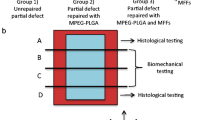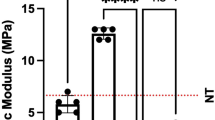Abstract
Introduction and hypothesis
Mesh-augmented reconstructive surgery for pelvic organ prolapse (POP) does not meet clinical expectations. A tissue-engineered fascia equivalent needs to be developed.
Methods
Human vaginal fibroblasts (HVFs) from 10 patients were characterized in vitro. Eligible HVFs and a biodegradable scaffold were used to fabricate a fascia equivalent, which was then transplanted in vivo.
Results
The cultured HVFs were divided into high (n = 6) or low (n = 4) collagen I/III ratio groups. Cells of the high-ratio group exhibited significantly higher proliferation potential than those of the low-ratio group (P < 0.05). A fascia equivalent was made with HVFs of the high-ratio group. In the subsequent animal study, a well-organized neo-fascia formation containing HVFs could be traced up to 12 weeks after transplantation.
Conclusions
Our results suggest that a tissue-engineered fascia could be developed from HVFs in vitro and in vivo, which might be an effective treatment for POP in the future.




Similar content being viewed by others
Abbreviations
- POP:
-
Pelvic organ prolapse
- SUI:
-
Stress urinary incontinence
- HVFs:
-
Human vaginal fibroblasts
- PBS:
-
Phosphate-buffered saline
- DMEM:
-
Dulbecco’s modified Eagle medium
- FBS:
-
Fetal bovine serum
- FITC:
-
Fluorescein isothiocyanate
- DAPI:
-
4,6-Diamidino-2-phenylindole dihydrochloride
- HRP:
-
Horseradish peroxidase
- ECL:
-
Enhanced chemiluminescence
- PLGA:
-
Poly-dl-lactico-glycolic acid
References
Olsen AL, Smith VJ, Bergstrom JO, Colling JC, Clark AL (1997) Epidemiology of surgically managed pelvic organ prolapse and urinary incontinence. Obstet Gynecol 89:501–506
Bump RC, Norton PA (1998) Epidemiology and natural history of pelvic floor dysfunction. Obstet Gynecol Clin North Am 25:723–746
Silva WA, Karram MM (2005) Scientific basis for use of grafts during vaginal reconstructive procedures. Curr Opin Obstet Gynecol 17:519–529
Jia X, Glazener C, Mowatt G, MacLennan G, Bain C, Fraser C, Burr J (2008) Efficacy and safety of using mesh or grafts in surgery for anterior and/or posterior vaginal wall prolapse: systematic review and meta-analysis. Br J Obstet Gynaecol 115:1350–1361
Baessler K, Maher CF (2006) Mesh augmentation during pelvic-floor reconstructive surgery: risks and benefits. Curr Opin Obstet Gynecol 18:560–566
Dwyer PL (2009) Minimally invasive surgery in urogynecology. Int Urogynecol J Pelvic Floor Dysfunct 20:485–486
De Filippo RE, Yoo JJ, Atala A (2003) Engineering of vaginal tissue in vivo. Tissue Eng 9:301–306
Atala A, Bauer SB, Soker S, Yoo JJ, Retik AB (2006) Tissue-engineered autologous bladders for patients needing cystoplasty. Lancet 367:1241–1246
Mitterberger M, Marksteiner R, Margreiter E, Pinggera GM, Colleselli D, Frauscher F, Ulmer H, Fussenegger M, Bartsch G, Strasser H (2007) Autologous myoblasts and fibroblasts for female stress incontinence: a 1-year follow-up in 123 patients. Br J Urol Int 100:1081–1085
Carr LK, Steele D, Steele S, Wagner D, Pruchnic R, Jankowski R, Erickson J, Huard J, Chancellor MB (2008) 1-Year follow-up of autologous muscle-derived stem cell injection pilot study to treat stress urinary incontinence. Int Urogynecol J Pelvic Floor Dysfunct 19:881–883
Nakanishi Y, Chen G, Komuro H, Ushida T, Kaneko S, Tateishi T, Kaneko M (2003) Tissue-engineered urinary bladder wall using PLGA mesh-collagen hybrid scaffolds: a comparison study of collagen sponge and gel as a scaffold. J Pediatr Surg 38:1781–1784
Weiss RA, Weiss MA, Beasley KL, Munavalli G (2007) Autologous cultured fibroblast injection for facial contour deformities: a prospective, placebo-controlled, Phase III clinical trial. Dermatol Surg 33:263–268
Mäkinen J, Kähäri VM, Söderström KO, Vuorio E, Hirvonen T (1987) Collagen synthesis in the vaginal connective tissue of patients with and without uterine prolapse. Eur J Obstet Gynecol Reprod Biol 24:319–325
Rosch R, Klinge U, Si Z, Junge K, Klosterhalfen B, Schumpelick V (2002) A role for the collagen I/III and MMP-1/-13 genes in primary inguinal hernia? BMC Med Genet 3:2
Zheng H, Si Z, Kasperk R, Bhardwaj RS, Schumpelick V, Klinge U, Klosterhalfen B (2002) Recurrent inguinal hernia: disease of the collagen matrix? World J Surg 26:401–408
Segev Y, Auslender R, Feiner B, Lissak A, Lavie O, Abramov Y (2009) Are women with pelvic organ prolapse at a higher risk of developing hernias? Int Urogynecol J Pelvic Floor Dysfunct 20:1451–1453
Chen G, Sato T, Ohgushi H, Ushida T, Tateishi T, Tanaka J (2005) Culturing of skin fibroblasts in a thin PLGA-collagen hybrid mesh. Biomaterials 26:2559–2566
Vandevord PJ, Broadrick KM, Krishnamurthy B, Singla AK (2009) A comparative study evaluating the in vivo incorporation of biological sling materials. Urology (in press)
Zong W, Zyczynski HM, Meyn LA, Gordy SC, Moalli PA (2007) Regulation of MMP-1 by sex steroid hormones in fibroblasts derived from the female pelvic floor. Am J Obstet Gynecol 196(349):e1–11
Zong W, Meyn LA, Moalli PA (2009) The amount and activity of active matrix metalloproteinase 13 is suppressed by estradiol and progesterone in human pelvic floor fibroblasts. Biol Reprod 80:367–374
Bhatia NN, Ho MH (2004) Stem cell therapy for urinary incontinence and pelvic floor disorders: a novel approach. Curr Opin Obstet Gynecol 16:397–398
Lee CH, Moioli EK, Mao JJ (2006) Fibroblastic differentiation of human mesenchymal stem cells using connective tissue growth factor. Conf Proc IEEE Eng Med Biol Soc 1:775–778
Acknowledgments
We thank MY Lee and YF Lin for their technical assistance. This study was supported by Taichung Veterans General Hospital and Tunghai University (TCVGH-T) grant no. 947808, 957802, and 967803.
Conflicts of interest
None.
Author information
Authors and Affiliations
Corresponding author
Rights and permissions
About this article
Cite this article
Hung, MJ., Wen, MC., Hung, CN. et al. Tissue-engineered fascia from vaginal fibroblasts for patientsneeding reconstructive pelvic surgery. Int Urogynecol J 21, 1085–1093 (2010). https://doi.org/10.1007/s00192-010-1168-3
Received:
Accepted:
Published:
Issue Date:
DOI: https://doi.org/10.1007/s00192-010-1168-3




